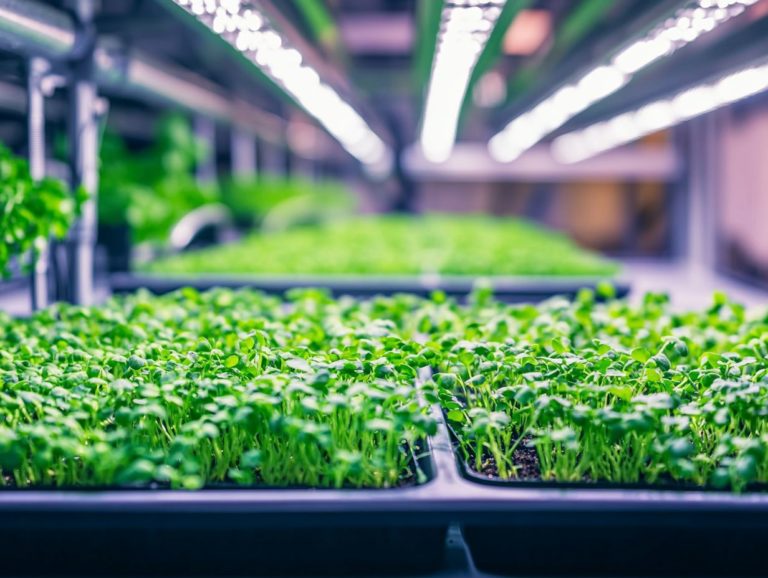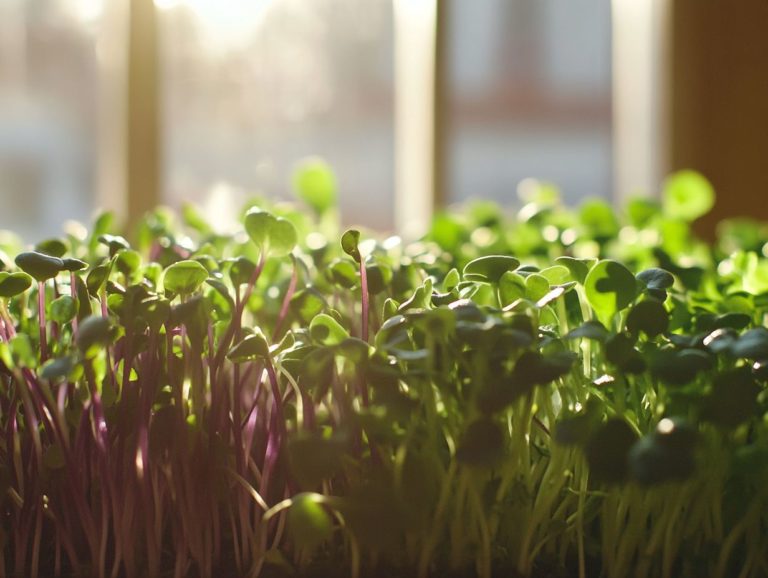Organic vs. Conventional Microgreen Growing
Microgreens are small yet mighty plants, bursting with nutrients that can elevate both your meals and your health.
Whether you re a seasoned gardener or just dipping your toes into gardening, understanding the differences between organic and conventional growing methods is crucial. This knowledge is especially important when considering the nutritional content of various microgreen varieties.
This conversation will guide you through the benefits and drawbacks of each approach, dive into the organic certification process, and compare the nutritional values and costs while exploring the culinary uses of microgreens.
By the end of this journey, you ll be well-equipped to select the microgreen growing method that best suits your needs and learn valuable gardening tips.
Contents
- Key Takeaways:
- Organic Microgreen Growing
- Conventional Microgreen Growing
- Comparing the Nutritional Value of Organic and Conventional Microgreens
- Cost Comparison
- Choosing the Right Method for You
- Frequently Asked Questions
- 1. What is the difference between organic and conventional microgreen growing?
- 2. Is one method better than the other for growing microgreens?
- 3. Are organic microgreens more nutritious than conventional ones?
- 4. Can I use organic methods for growing microgreens if I am not a certified organic farmer?
- 5. Is it more expensive to grow microgreens organically?
- 6. Can I convert from conventional to organic microgreen growing?
Key Takeaways:
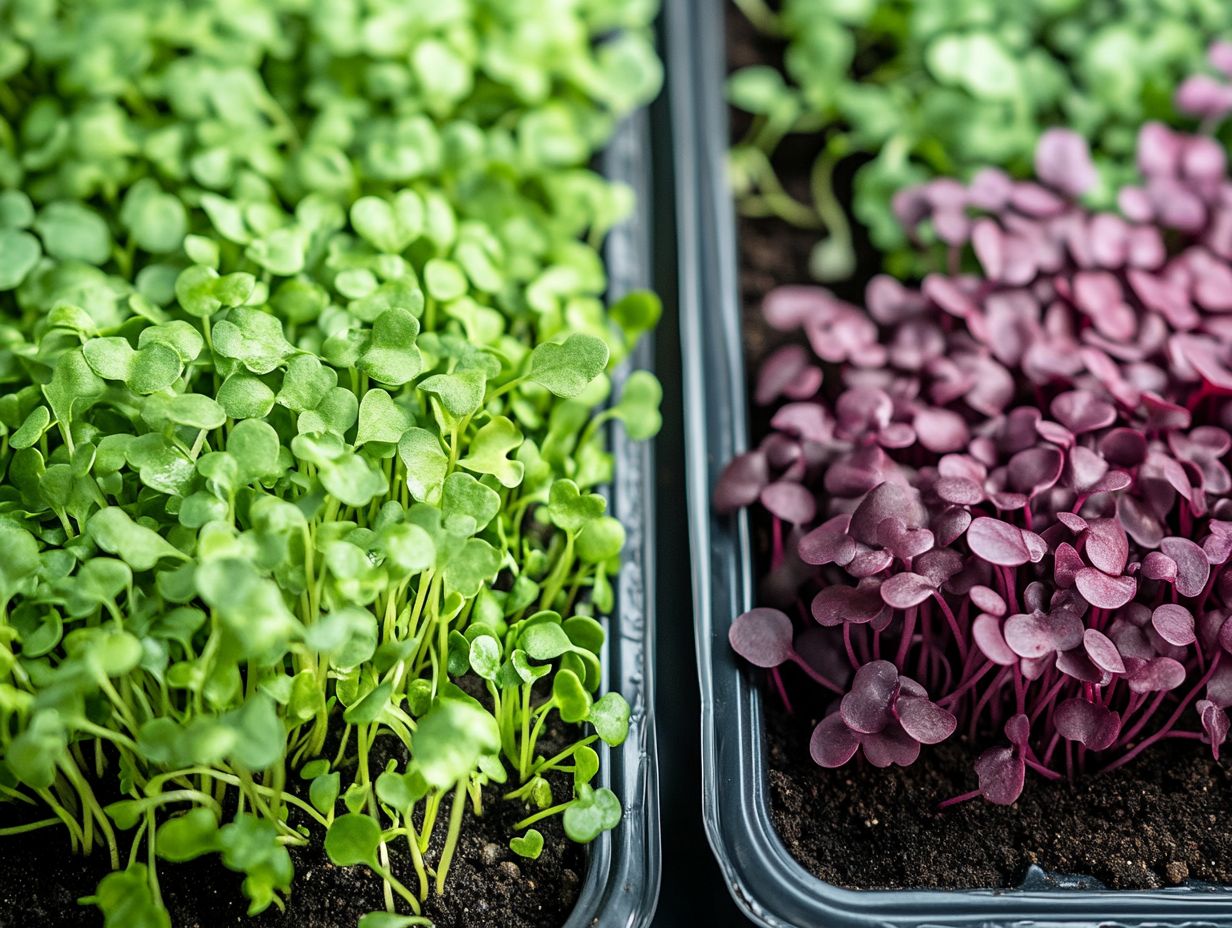
- Organic microgreen growing uses natural methods and has numerous benefits, such as being free of harmful chemicals, preserving soil health, and promoting sustainable farming practices.
- Conventional microgreen growing may have advantages, such as higher yields, but it also has drawbacks, including potential pesticide residue that can affect the nutrient profiles of the produce.
- Research on the nutritional value of organic vs. conventional microgreens is inconclusive. However, choosing organic can offer peace of mind and support sustainable farming practices, especially for those interested in community-supported agriculture.
What are Microgreens?
Microgreens are delightful edible greens harvested just after the first real leaves appear. They offer a vibrant burst of flavor and a rich nutritional profile that attracts health-conscious consumers and culinary enthusiasts.
Varieties like radish, cilantro, and arugula bring vivid colors and concentrated nutrients, making them a beloved choice for garnishing dishes and enhancing salads. With the rising interest in sustainable farming practices and organic microgreens, they ve carved out a niche in urban farming and indoor gardening.
Their rapid growth cycle, often just a couple of weeks, means you can enjoy quick turnover perfect for both home growers and commercial operations. Packed with vitamins, minerals, and antioxidants, microgreens are truly powerhouses of nutrition that you ll love to include in your daily diet!
These greens aren t just for show; they can elevate the flavors in a myriad of dishes, from soups to sandwiches. They beautifully align with organic farming practices that prioritize sustainability and chemical-free cultivation methods. As the trend toward healthier eating and eco-friendly practices continues to gain momentum, the allure of microgreens is bound to flourish even more.
Organic Microgreen Growing
Growing organic microgreens requires a meticulous approach that emphasizes sustainability and quality. This allows health-conscious consumers to savor the freshest greens while simultaneously promoting soil health and environmental benefits.
By choosing organic seeds, selecting the right varieties, and employing best farming practices, you can cultivate microgreens that deliver superior flavors and satisfy the growing demand for organic produce.
Ready to spice up your meals? Start growing your own microgreens today for fresh flavors and amazing health benefits!
Benefits of Organic Growing Methods
The benefits of organic growing methods extend well beyond just the produce; they offer a complete method that enhances health for both you and the environment. By adopting organic practices, you ensure that your crops are free from harmful pesticides and fertilizers. This enhances the nutritional value of microgreens and supports soil health while fostering ecological balance and disease resistance.
These methods also elevate crop quality and significantly contribute to the sustainability of agricultural land. By utilizing natural fertilizers and implementing crop rotation the practice of growing different crops in the same area across seasons organic practices improve soil structure and fertility, promoting richer biodiversity. This sustainable cultivation method effectively mitigates soil erosion and reduces water pollution by preventing the excess runoff of chemicals into local waterways.
You get access to food that is both nutritious and safe, contributing to better overall health. Embracing organic growing methods ultimately leads to thriving ecosystems that can support future generations.
Organic Certification Process
The organic certification process is a crucial milestone for you as a grower. It establishes your credibility and attracts health-conscious consumers who prioritize organic practices in their purchasing decisions. This rigorous process ensures that all your farming methods meet the standards set by regulatory bodies. It allows you to effectively brand your microgreens and educate customers about the benefits of choosing organic produce.
By adhering to strict regulations such as maintaining soil health, ensuring sustainable pest management, and using non-GMO seeds you not only comply with required practices but also showcase your commitment to environmental stewardship. The journey to certification involves meticulous record-keeping, annual inspections, and ongoing education on organic farming techniques to maintain compliance.
Achieving this credibility enhances your branding efforts and fosters deeper customer trust. Consumers become increasingly aware of and appreciative of the value of certified organic produce. Such transparency helps you build a loyal customer base seeking to support businesses aligned with their values, amplifying the significance of organic farming in today s marketplace.
Conventional Microgreen Growing
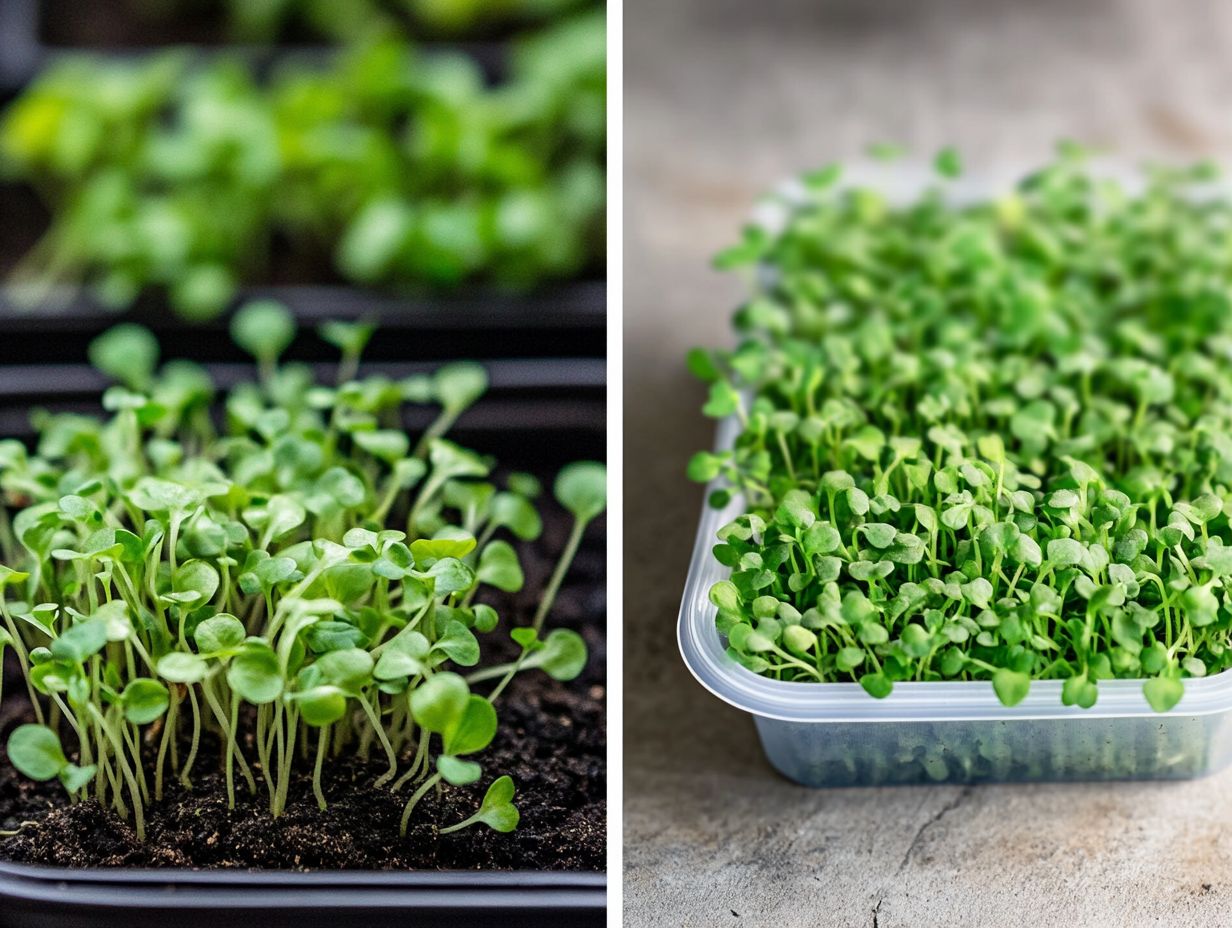
Conventional microgreen growing involves a variety of agricultural practices aimed at maximizing yields and economic benefits. This is why it has become a favored choice among urban farmers and large-scale operations. While this approach may incorporate techniques like pest management and targeted seed selection, it s crucial for you to reflect on the implications for health, nutrient profiles, and the overall sustainability of the farming methods you choose to employ.
Advantages and Disadvantages
When evaluating the pros and cons of conventional microgreen growing, it s essential to consider the economic benefits alongside potential health risks and environmental impacts. While traditional methods can yield higher outputs at lower costs, they might compromise nutrient quality and raise concerns about pesticide use issues that are increasingly important for health-conscious consumers.
These health implications can include exposure to harmful residues on produce, which may have a detrimental effect on overall well-being. The environmental footprint of these conventional practices often draws scrutiny; reliance on fertilizers and excessive water usage can worsen problems like soil depletion and pollution.
On the flip side, the economic benefits are hard to ignore. They enable growers to produce larger quantities at a reduced cost, appealing to both commercial operations and enthusiastic home gardeners. Choose wisely! Understanding these factors will guide you to a more responsible and health-focused growing method.
Comparing the Nutritional Value of Organic and Conventional Microgreens
When you delve into the nutritional comparison of organic and conventional microgreens, you’ll uncover valuable insights regarding the benefits each approach offers. Research consistently highlights notable differences in nutrient profiles and health advantages.
In fact, organic microgreens frequently surpass their conventional counterparts, boasting higher levels of antioxidants and enhanced overall nutrient density. For those interested in the cultivation process, understanding the science behind microgreen growth can be invaluable. This makes organic microgreens an excellent choice for those who prioritize nutrient-rich foods in their diet.
Research and Findings
Many studies have looked into the nutritional value of microgreens, uncovering compelling evidence that highlights the health benefits tied to various growing practices. These studies show that organic microgreens tend to boast much higher levels of essential vitamins and minerals, ultimately influencing your choices towards healthier eating habits.
For example, a study published in the *Journal of Agricultural and Food Chemistry* pointed out that organic varieties exhibited much higher levels of Vitamins C, E, and K compared to their conventional counterparts (Xiao et al., 2012). Research from the *International Journal of Food Sciences and Nutrition* also showed that organic microgreens not only offer a richer nutrient profile but also contain higher levels of beneficial phytochemicals that may enhance your overall well-being (Liu et al., 2016). To get started with growing your own, you can explore understanding microgreen growing supplies for the best results.
Choosing organic microgreens could enhance your health benefits, making them a valuable addition to your diet aimed at improving nutrition and combating chronic diseases.
Cost Comparison
Understanding the cost comparison between organic and conventional microgreens is crucial for both consumers and businesses, as it plays a significant role in shaping purchasing decisions and the economic advantages linked to each approach.
Although organic microgreens typically carry a higher price, they offer exceptional value through enhanced nutrient density and a multitude of health benefits. This added appeal is drawing an increasingly discerning market of health-conscious consumers who prioritize quality. To maximize their growth, consider using natural fertilizers for microgreen growth.
Organic vs. Conventional Microgreen Prices

When you compare the prices of organic and conventional microgreens, it’s crucial to grasp the factors that drive these costs, from production methods to market demand. Organic microgreens often carry a higher price tag due to the labor-intensive farming practices involved. However, many consumers are willing to invest in their health and the environment, which makes educating them a vital part of the conversation.
By understanding the various elements that contribute to pricing such as seed quality, soil health, and pest management techniques you can gain clearer insight into why organic options might be pricier. Market dynamics, including local supply availability and consumer trends, also significantly influence these prices.
By educating potential buyers on the nutritional benefits and safety standards associated with organic produce, you foster a deeper appreciation for these products.
This knowledge gives you the power to recognize not only the financial implications of your choices but also their broader impact on sustainable farming practices.
Choosing the Right Method for You
Selecting the ideal method for cultivating microgreens requires thoughtful consideration of several key factors, including the health benefits they offer, the space you have available, and the gardening techniques that align with your personal objectives.
Begin by assessing your priorities and resources. This introspection will empower you to make an informed decision that harmonizes with your lifestyle and nutritional aspirations.
Discover the amazing benefits of organic microgreens! Whether you lean towards organic or conventional practices, it s essential to align your choices with your personal goals.
Factors to Consider
When assessing the factors that affect growing microgreens, balance health and economic benefits with your unique capabilities and goals. Considerations like available space, time commitment, and your desired crop yield the amount of plants you can grow will significantly shape your approach.
Don t overlook the nutritional value of microgreens. They re brimming with vitamins and minerals, making them a favored choice among health-conscious individuals. Economic aspects, such as market demand and potential yield per square foot, can also influence your decisions, especially if you aim to sell your harvest.
Incorporating practical gardening tips will boost both growth and flavor, making your microgreens irresistibly tasty! Tips like optimal lighting conditions and the right soil choices should be part of your decision-making process. By weaving these factors together, you can craft a personalized plan that complements your lifestyle while maximizing health benefits and economic returns.
Frequently Asked Questions
1. What is the difference between organic and conventional microgreen growing?
Organic microgreen growing refers to using natural and sustainable methods without synthetic pesticides or fertilizers. Conventional microgreen growing involves chemical pesticides and fertilizers.
2. Is one method better than the other for growing microgreens?
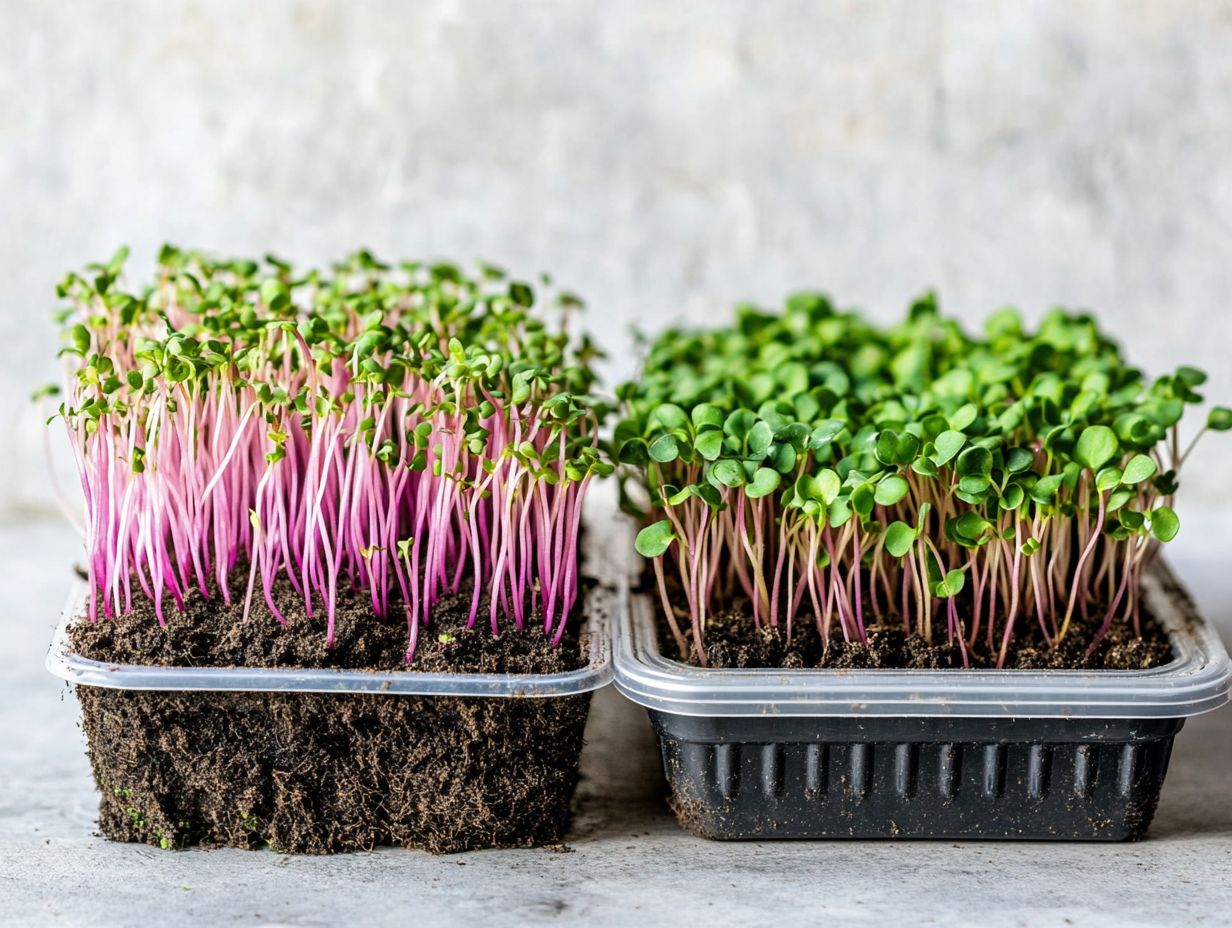
It ultimately depends on personal preference and values. While organic methods may be more environmentally friendly, conventional methods may yield larger and faster-growing microgreens.
3. Are organic microgreens more nutritious than conventional ones?
There is no conclusive evidence that organic microgreens are more nutritious than conventional ones. However, organic microgreens may contain lower levels of chemical residues, which can be beneficial for health.
4. Can I use organic methods for growing microgreens if I am not a certified organic farmer?
Yes, anyone can use organic methods for growing microgreens, even if they are not certified. However, to sell them as “organic,” you must be certified by an accredited organization.
5. Is it more expensive to grow microgreens organically?
Yes, organic methods for growing microgreens may be more expensive as they often require more manual labor and natural inputs. However, the long-term environmental and health benefits may outweigh the initial costs.
6. Can I convert from conventional to organic microgreen growing?
Yes, it is possible to convert from conventional to organic microgreen growing, but it may take some time and effort to transition and find alternative methods for pest and weed control without chemicals.
Start growing your own microgreens today and enjoy delicious, nutritious benefits!

